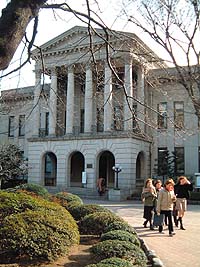Forcing Universities to Face the Market
Back to Contents of Issue: December 2002
|
by Sumie Kawakami |
|
 KOICHI TANAKA'SWINNING OF this year's Nobel Prize in chemistry was a pleasant surprise for Japan. Coupled with Masatoshi Koshiba, who also won the prize in physics, Tanaka suddenly became one of the nation's hottest celebrities. Tanaka's ordinary appearance -- which the prizewinner himself joked about -- was especially appealing to the Japanese masses; TV programs repeatedly showed him wearing his company uniform. KOICHI TANAKA'SWINNING OF this year's Nobel Prize in chemistry was a pleasant surprise for Japan. Coupled with Masatoshi Koshiba, who also won the prize in physics, Tanaka suddenly became one of the nation's hottest celebrities. Tanaka's ordinary appearance -- which the prizewinner himself joked about -- was especially appealing to the Japanese masses; TV programs repeatedly showed him wearing his company uniform. Holding hands with the two Nobel-winning scientists, even struggling prime minister Junichiro Koizumi looked happy. But in order for Japan to use its scientific discoveries to make its economy more competitive, the country needs to go through more reforms, especially in the area of university education. The Koizumi Cabinet says university reforms are one of its priorities. In October, the Japan Society for the Promotion of Science decided to award research grants for 113 programs at 50 universities under the Education Ministry's "21st Century COE (Center of Excellence) Program." The program came into existence last year as part of the much-debated structural reforms pledged by the Koizumi Cabinet. The aim of the program is to allocate a budget to doctoral research projects so that Japan's universities become internationally competitive. For the first year, the government has allocated JPY18.2 billion for the program. The grants will be distributed among these 113 programs; the breakdown of funding allocations was announced in late October. The University of Tokyo and Kyoto University each won grants for 11 programs -- the highest number -- followed by Nagoya and Osaka universities, with seven programs each, and Tohoku, Waseda and Keio universities, with five apiece. A ministry official explains that the selection was done by the society's five working committees, independent of the ministry. The selection committee is headed by Leo Esaki, a 1973 Nobel laureate in physics. But the way in which the awards were granted poses some questions. Out of the 113 programs, 84 were from national universities (74.34 percent), four were from other public universities (3.54 percent) and 25 were from private schools (22.12 percent). Tokai University dean Kiyoshi Kurokawa reportedly noted that national universities are already heavily subsidized by the ministry; their edge on the competition is virtually guaranteed. Another criticism of the grant program is that methods and criteria for the selections weren't made public. There were some obvious winners -- like Meiji University's nanotechnology program, led by world-renowned scientist Sumio Iijima, who discovered the atomic structure of carbon nanotubes. But the public was generally clueless about why some programs were awarded and others ignored. Structural reform of national universities is a pressing issue for Japan because of its plan to transform national universities into independent administrative corporations by fiscal 2004. Although details of the proposed plan are subject to further discussion, and the change would not involve the immediate privatization of national universities, it is certain that these schools will be exposed to at least some form of market competition. In the meantime, Japan's prolonged economic difficulties combined with a declining student population are forcing private entities to review the costs and benefits of massive research projects. This seems to point to the need for university reforms, but more debate is needed on how the government will support that process. -- Sumie Kawakami (From the J@pan Inc newsletter, a free email newsletter published every Wednesday. Subscribe to our free email newsletters at www.japaninc.com/subscribe_news.html.) |
|
Note: The function "email this page" is currently not supported for this page.





